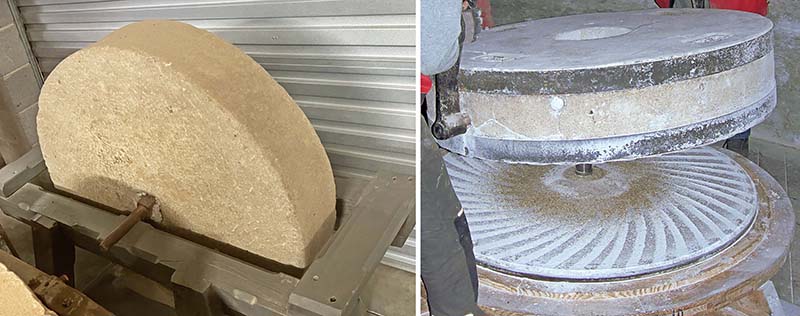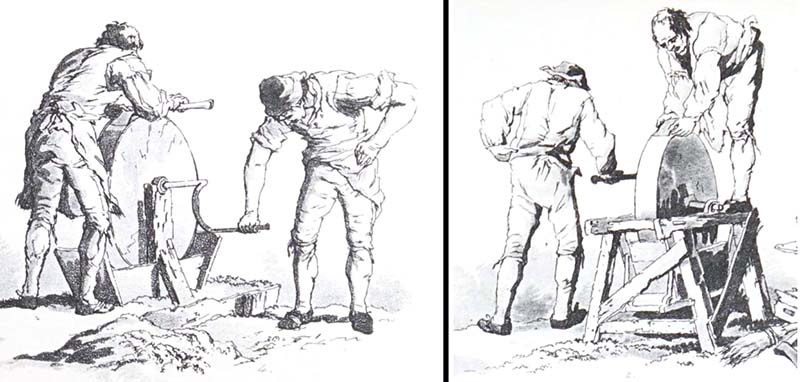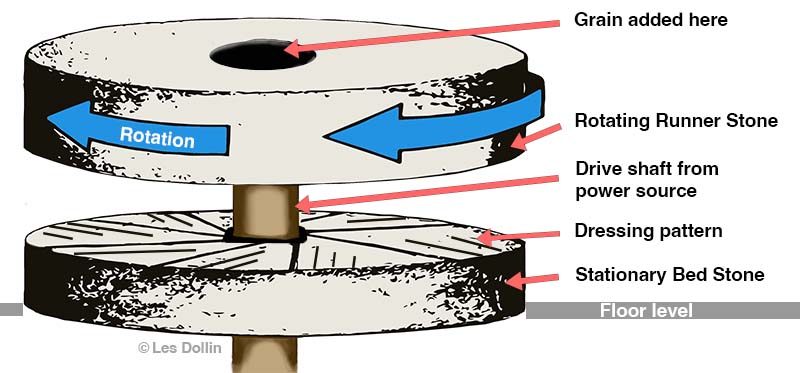
Grindstones:
Usually Used for Sharpening Steel
AKA: Grind stones, Grinding stones
Singleton Mills homepage > Overview of millstones > Grinding stones
Grindstones versus millstones
The terms 'Grindstone', 'Grinding stone', and Millstone' can be confusing! Sometimes the word 'Grindstone' was used as an alternative name for a 'Millstone'.
However, a 'Grindstone' usually referred to a device for sharpening tools, while pairs of 'Millstones' were used for grinding flour. On this page, we explain their differences.

Above left, this large grindstone, mounted in a wooden frame and once used for sharpening steel tools, is on display at the excellent Golden Memories Millthorpe Museum, NSW. Above right, two large millstones are being placed face to face in a flour mill, where they will be used to mill grain. Photograph sources: left, Anne Dollin; right, Rasbak, Wikimedia Commons.
A grindstone, designed to sharpen steel knives and other implements, consisted of a smooth sided disk of an abrasive stone, such as Millstone Grit. It was mounted vertically in a frame. See illustration below. An axle passed through a hole in the centre of the stone, and often a crank handle was attached to this handle. One person would turn the crank handle to make the stone rotate. Another person could then sharpen their steel blade by pressing it against the edge of the grinding stone. Sometimes a trough holding water was placed under the grindstone to keep the stone wet during the sharpening work.

Above, two sketches by WH Pyne (1806) of men using grindstones to sharpen their tools. One man in each pair turns a crank handle to rotate the stone. Each stone has a water-filled trough underneath it. From: 'Microcosm'; or 'A picturesque delineation of the arts, agriculture, and manufactures of Great Britain', by William Henry Pyne. archive.org
In contrast, Millstones, for grinding flour, were mounted horizontally in pairs. Grain was poured into a small gap between the stones, and the grinding action milled the grain into flour.

Above, a simplified diagram showing how a pair of millstones is set up in a flour mill. The two millstones are shown in separate positions in this diagram, so that the mechanism can be clearly seen. However, during the milling process, the Runner Stone and the Bed Stone almost touch one another, face-to-face. Diagram by Les Dollin.
Read More About Millstones
•• Overview •• French Burr Stones •• Basalt-like Cullin Stones •• Millstone Grit •• Old Red Sandstone, Puddingstone, and Lodswoth Stone •• Granite •• Limestone •• Artificial Millstones •• Norfolk Island Millstones •• Colonial Millstones ••